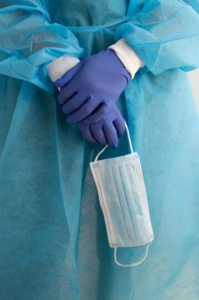Material used in MedTech Textile

Materials used in Medical Technical Textiles
Medtech textiles, which are used in medical applications, are crafted from a variety of materials designed to meet strict hygiene, safety, and functional requirements. These materials must often be biocompatible, non-toxic, and able to withstand sterilization. Below are the key materials commonly used in Medtech textiles:
- 1. Natural Fibers:
- Cotton: Used for its softness, breathability, and absorbency in products like wound dressings, bandages, and surgical gowns. It is sterilizable and biodegradable.
- Silk: Used in sutures due to its smoothness and tensile strength. It is naturally biocompatible.
- Wool: Sometimes used in specialized medical textiles for its insulating and moisture-wicking properties.
- 2. Synthetic Fibers:
- Polypropylene (PP): Widely used for non-woven fabrics in disposable medical products such as face masks, surgical gowns, and sterilization wraps. It is lightweight, strong, and has good chemical resistance.
- Polyethylene (PE): Used in medical textiles like surgical drapes and protective clothing. It is resistant to moisture and has good barrier properties.
- Polyamide (Nylon): Commonly used in surgical sutures and some types of medical bandages due to its strength and flexibility.
- Polyester (PET): Used in surgical gowns, medical tapes, and implantable textiles. It is durable, has low moisture absorption, and is resistant to chemicals and stretching.
- Polylactic Acid (PLA): A biodegradable material used in absorbable sutures and drug delivery systems.
- 3. Biodegradable Polymers:
- Polyglycolic Acid (PGA): Used in absorbable sutures; it is biodegradable and provides high tensile strength.
- Polylactic-co-glycolic Acid (PLGA): Used for sutures and drug delivery systems. It is biocompatible and biodegradable.
- Polycaprolactone (PCL): Used in tissue engineering scaffolds and medical implants due to its biodegradability and slow degradation rate.
- 4. Elastomeric Fibers:
- Polyurethane (PU): Used in wound dressings, bandages, and breathable medical textiles. It offers flexibility, durability, and moisture resistance.
- Silicone: Commonly used in medical tubing, wound care products, and prosthetics due to its biocompatibility, flexibility, and resistance to infection.
- Spandex (Lycra): Blended with other fibers to create elastic and form-fitting medical garments, compression stockings, and orthopedic supports.
- 5. Non-Woven Fabrics:
- Spunbond Polypropylene (SBPP): Widely used in disposable medical textiles like face masks, surgical gowns, and sterile wraps. It provides good filtration, breathability, and strength.
- Meltblown Polypropylene: Used in high-efficiency filtration products like medical face masks (N95), as it offers excellent filtration efficiency.
- Hydroentangled Non-wovens: Used in wound dressings and surgical drapes for their softness, absorbency, and strength.
- 6. Antimicrobial Coatings:
- Silver-coated Fibers: Used in wound dressings and medical textiles to prevent bacterial growth. Silver ions provide strong antimicrobial properties.
- Copper-coated Fibers: Another antimicrobial material used in healthcare environments for fabrics that reduce the risk of infections.
- Chitosan: A biopolymer derived from chitin (found in shellfish), used in wound dressings and other medical textiles for its antimicrobial and healing properties.
- 7. Hydrogels:
- Polyvinyl Alcohol (PVA) and Polyethylene Glycol (PEG): Used in wound care products and drug delivery systems. Hydrogels provide moisture and aid in the healing process.
- 8. Nanofibers and Smart Materials:
- Electrospun Nanofibers: Used for tissue scaffolds, drug delivery systems, and advanced wound dressings due to their small fiber diameter and high surface area.
- Smart Textiles: Embedded with sensors or responsive materials that can monitor patients’ vital signs or release drugs in a controlled manner.
The choice of material depends on the specific requirements of the medical application, such as biocompatibility, sterility, durability, and patient comfort.



